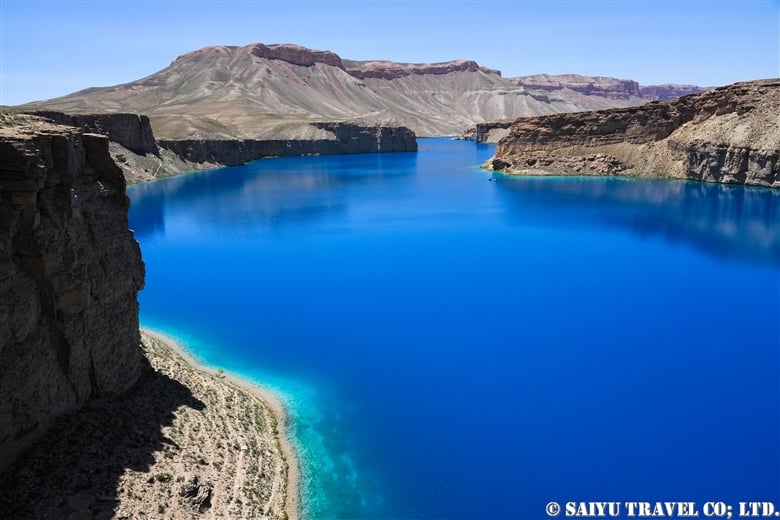
Band-e Amir is a group of lakes located 75 km west of Bamiyan at an altitude of approximately 3,000 meters. Band-e Amir is so beautiful that it is often referred to as the ”Pearl of the Desert,” and is the most picturesque site in Afghanistan, which has many spectacular views.
The road from Bamiyan to Band-e Amir crosses the beautiful valleys and passes of Shahidan. In summer, the road offers spectacular views of the green meadows, which feature beautiful alpine vegetation and pastures. The road before the lake is now paved, making it much easier to access.

Departing from Bamiyan, shortly after passing the checkpoint for the Kotal Aqrabat Pass, a watchtower dating back to the Islamic period can be seen in front of you. The watchtowers, dating back to the Ghurid dynasty in the 12th century, remain along the roads around Bamiyan.

As you ascend the Shahidan pass, you will see the snow-capped mountains of the Hindu Kush, smooth green meadows, and grazing livestock.

Healthy goats and sheep blessed with abundant water and grass!

Ruins of a medieval castle (fortress) in the village of Shahidan. It is a proof that people have been passing through the area as part of the “Silk Road” for a long time. There is also a small bazaar.

There was also a school, the Hazara girls were just heading to class.

From Shahidan, drive along a scenic road through Shebartu and Qarghanatu, and finally enter the road to Band-e Amir. A large gate has recently been built. From here, the road is unpaved.

Driving slowly along the dirt road, you will see a beautiful lake in front of you. This is the first view of Band-e Amir. This is part of Band-e Zulfiqar. You will be surprised at how beautiful the color blue can be as it appears in the midst of the desolate landscape.
The ticket office is just ahead, and further along the road, the viewpoint of the main lake, Band-e Haibat, appears.

Band-e Haibat has a first and second parking lot (and a third on weekends…), accommodations, chaikhana, and even an amusement park of sorts. Since the new Taliban regime, the number of tourists from urban areas (especially Pashtuns) who never used to come to this area has increased, and the area has become so crowded that if you can choose the day of your visit, you should avoid the weekend.

For domestic tourists, boat rides are one of the must-do activities when visiting Bande Amir.

This is the 12-meter-high natural dam at Band-e Haibat. The wall (a natural dam) separating the lakes of Band-e Amir is composed of a calcium carbonate called travertine. Mineral-rich water seeping through faults and fissures in the rocky terrain has deposited layers of travertine that have been solidified over time, creating this natural dam.

This is a fish from Band-e Haibat, though we’re not sure of the species. Band-e Haibat is the deepest of the six lakes, about 150 meters deep, according to a survey by a New Zealand diving team.

There are a total of six lakes in Band-e Amir. Of these, Band-e Qambar is almost dry.
Band-e Zulfiqar (Lake of the sword of Ali)
Band-e Haibat (Lake of grandiose)
Band-e Gholaman (Lake of the slaves)
Band-e Qambar (Lake of Caliph Ali’s slave)
Band-e Panir (Lake of cheese)
Band-e Pudina (Lake of wild mint)
here is a shrine on the banks of Band-e Haibat that is considered sacred as the place where Hazrat Ali spent the night, and people have been making pilgrimages to the lake for a long time. In the past few years, the area has been transformed from a pilgrimage site to a major tourist destination.

Natural dam (travertine deposits) between Band-e Haibat (left), Band-e Paneer (right), and Band-e Pudina (top center right).

This photo shows Band-e Paneer and Band-e Pudina about 10 years ago. Now the topography seems to have changed a bit. Also, facilities for tourists have been built.

A boardwalk built between Band-e Paneer and Band-e Pudina. It continues to Band-e Zulfiqar

Picnic huts built around Bande Paneer. For domestic tourists, having a picnic in Band-e Amir is like a dream come true.
The truly beautiful Band-e Amir has become a major tourist attraction—one that is very crowded on weekends. However, we are very concerned about the water pollution caused by the garbage left by domestic tourists and the washing the leftover food.
By the way, on the way to Band-e Amir, you may encounter some very beautiful sights, such as the local Hazara people on the move.


We hope you enjoyed this showcase of the spectacular Band-e Amir and the Hazara people who live there. Afghanistan is always undergoing great changes, but we hope that all the ethnic groups living in Afghanistan can live in peace.
Photo & text : Mariko SAWADA
*Contact us, Indus Caravan for more information or to make arrangements for visiting Afghanistan, Bamiyan and Band-e Amir.
*Please follow us on Youtube, Instagram & Facebook
Category : ◆Afghanistan > - Bamiyan & aroundTag : Shahidan , Hotel Silkroad Bamiyan , Shebartu , Qarghanatu , Band-e Amir National Park , Afghanitsan Tourism , Band-e Haibat , Band-e Zulfiqar , Bamiyan , Band-e Pudina , Indus Caravan , Band-e Panir , Saiyu Travel , Bande Amir , #bandeamir , Afghanistan Travel Blog , Bande-i-Amir , Afghanistan Guide






